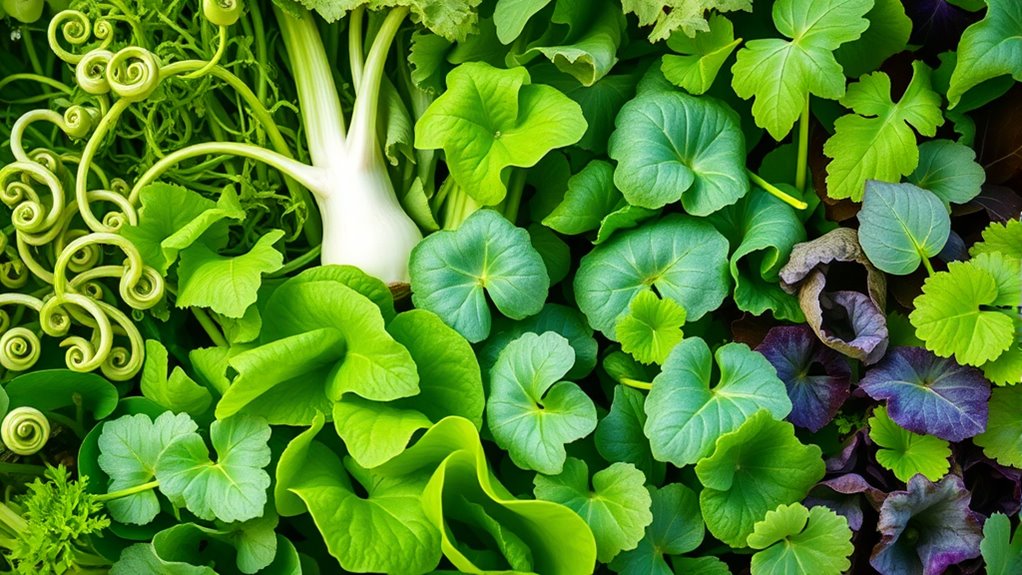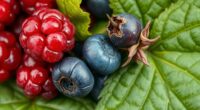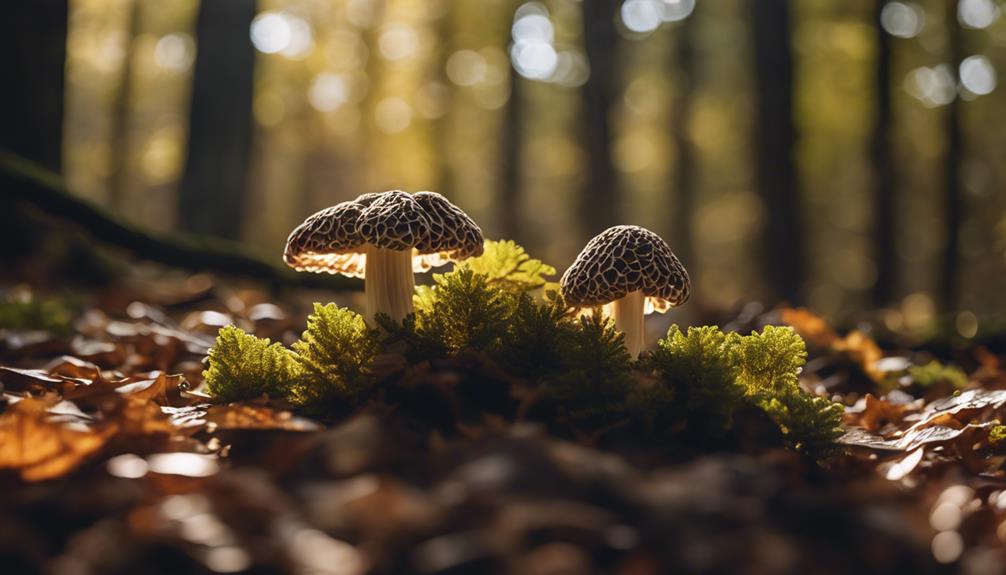You can find many nutritious spring greens in North America like lamb’s quarters, dandelion greens, and nettles, which are packed with vitamins and flavor. Other great options include chickweed, wild spinach, sorrel, mustard greens, wood sorrel, and cattails. These greens grow in various environments, and proper identification and harvesting are key for safety and sustainability. Keep exploring to discover how to harvest, prepare, and enjoy these delicious, seasonal greens.
Key Takeaways
- Early spring greens like lamb’s quarters, dandelion greens, and nettles are highly nutritious and widely foraged across North America.
- Common edible wild greens include chickweed, wild spinach, miner’s lettuce, sorrel, and wood sorrel, thriving in shaded or moist areas.
- Proper identification and sustainable harvesting are essential to safely enjoy these seasonal greens and support plant regeneration.
- Many of these greens can be eaten raw, sautéed, or preserved through freezing, pickling, or drying for year-round use.
- These top spring greens are valued for their flavor, nutritional content, and versatility in salads, soups, and cooked dishes.
Lamb’S Quarters (Chenopodium Album)
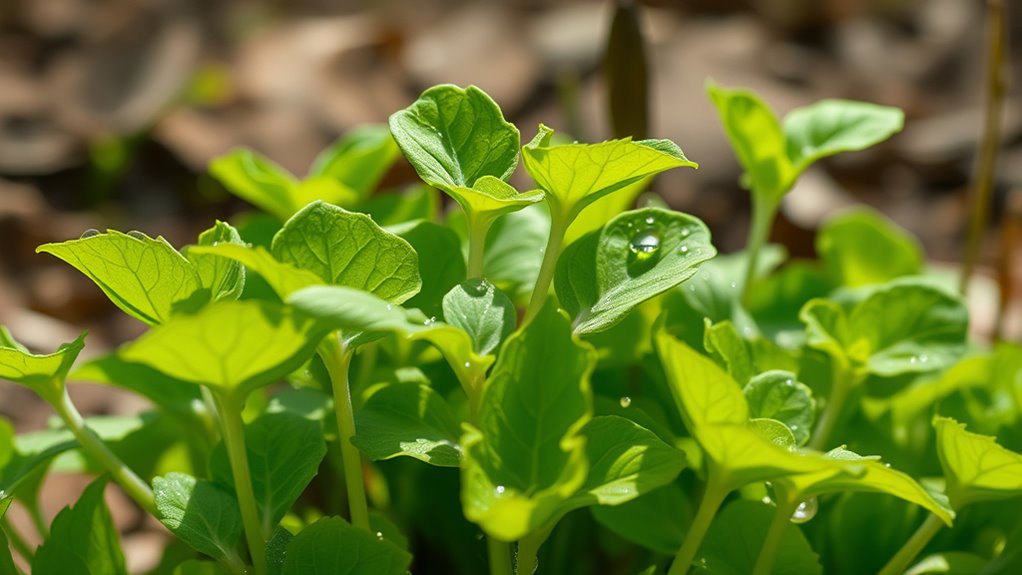
Lamb’s Quarters (Chenopodium album) is a versatile and nutritious edible spring green that you can easily forage in North America. When foraging, always prioritize safety by correctly identifying the plant to avoid confusion with toxic look-alikes. Harvest only what you need, ensuring you leave enough behind to allow the plant to regenerate and support local ecosystems. Sustainable harvesting involves picking young, tender leaves and stems, which are the most flavorful and nutritious. Avoid damaging the roots or overharvesting from a single patch. By practicing foraging safety and Sustainable harvesting, you help preserve Lamb’s Quarters for future seasons while enjoying its rich vitamins and minerals. Always wash the greens thoroughly before cooking or eating raw.
Dandelion Greens (Taraxacum Officinale)
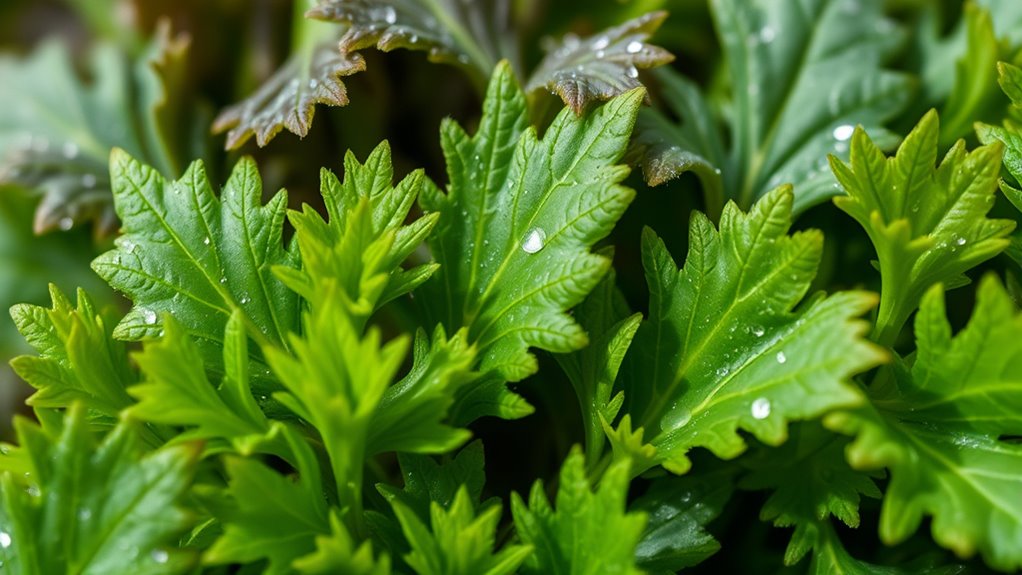
After harvesting Lamb’s Quarters, you might consider adding another nutrient-rich green to your foraging list: dandelion greens (Taraxacum officinale). These greens are easy to identify and can be foraged using simple techniques like pulling leaves from the base, avoiding any yellow flowers or roots. Dandelion greens are best collected in early spring before the flowers fully bloom, as their flavor is milder and more tender. They are seasonally available from early spring through late fall, depending on your location. Always verify you’re harvesting from areas free of pesticides and pollutants. Incorporating these greens into salads, sautés, or smoothies for a nutritious boost can be especially beneficial since foraging safety is crucial when collecting wild edibles. With proper foraging techniques, dandelion greens are a versatile, accessible wild green to add to your spring diet.
Nettles (Urtica Dioica)
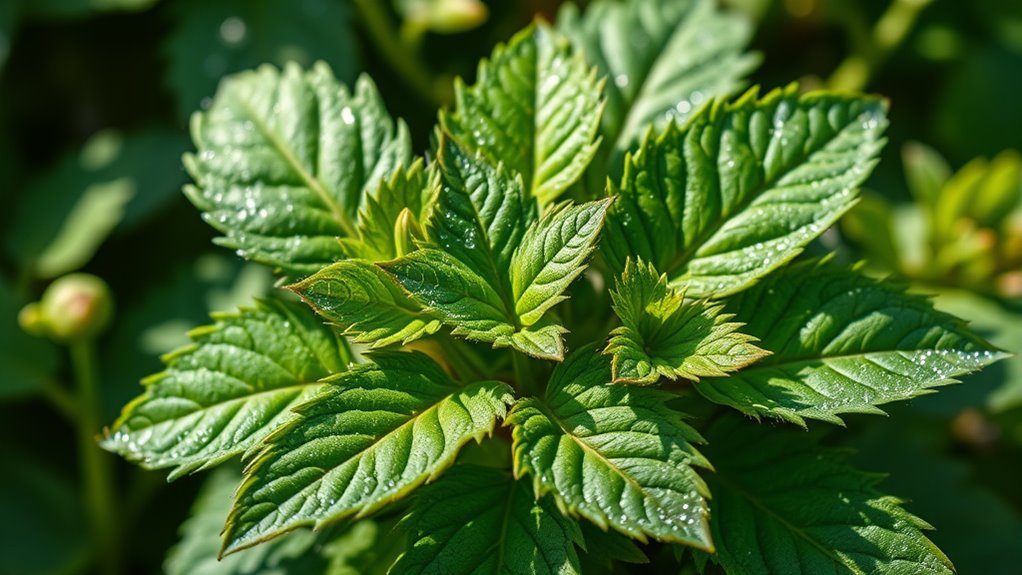
Nettles are a nutritional powerhouse, packed with vitamins, minerals, and antioxidants. When harvesting, you’ll want to wear gloves and pick them carefully to avoid their sting, then prepare them properly to neutralize the spines. You can incorporate them into soups, teas, or sautés, making them a versatile addition to your spring greens. Additionally, nutritional comparison shows that nettles provide significant calcium and magnesium, supporting overall bone health.
Nettles’ Nutritional Power
Nettles (Urtica dioica) are bursting with nutrients that make them a powerhouse among wild greens. Their dense vitamins, including A, C, and K, support your immune system and promote healthy skin. Rich in minerals like iron, calcium, and magnesium, they help boost energy and bone health. The high protein content makes them a great plant-based option. When foraging, prioritize safety by properly identifying the plant and wearing gloves to avoid stings. Understanding seasonal growth patterns ensures you harvest at peak nutritional value, typically in early spring when young shoots emerge. Additionally, harvesting during the plant’s peak growth period maximizes nutrient content. Consuming nettles provides a nutrient-dense addition to your diet, but always be cautious of foraging safety to enjoy their full benefits safely.
Harvesting and Preparing Nettles
To safely enjoy the nutritional benefits of nettles, proper harvesting and preparation are key. Always follow foraging ethics by sustainably harvesting only what you need and avoiding overharvesting. Focus on seasonal harvesting in spring when the young, tender leaves are at their peak. Use gloves to handle nettles and cut the top few inches of new growth with scissors or a knife. To preserve plant health, avoid damaging roots or overharvesting from the same patch. Additionally, understanding the plant biology of nettles can help identify the best harvest times and ensure sustainable foraging practices.
Culinary Uses of Nettles
You can enjoy nettles in a variety of delicious dishes, thanks to their versatility and rich nutritional profile. When using them, always prioritize foraging safety by correctly identifying the plant and avoiding contaminated areas. Once harvested, cooking techniques like blanching, steaming, or sautéing neutralize their sting and enhance flavor. Nettles work well in soups, stews, pesto, and teas, adding a mineral-rich boost to your meals. Be sure to handle them with gloves during preparation to prevent skin irritation. After cooking, their flavor becomes mild and earthy, making them a great substitute for spinach or kale. Incorporating nettles into your diet is easy and rewarding once you master proper foraging safety and effective cooking techniques. Proper handling and preparation are essential to enjoy the full benefits of this nutrient-dense greens safely.
Chickweed (Stellaria Media)
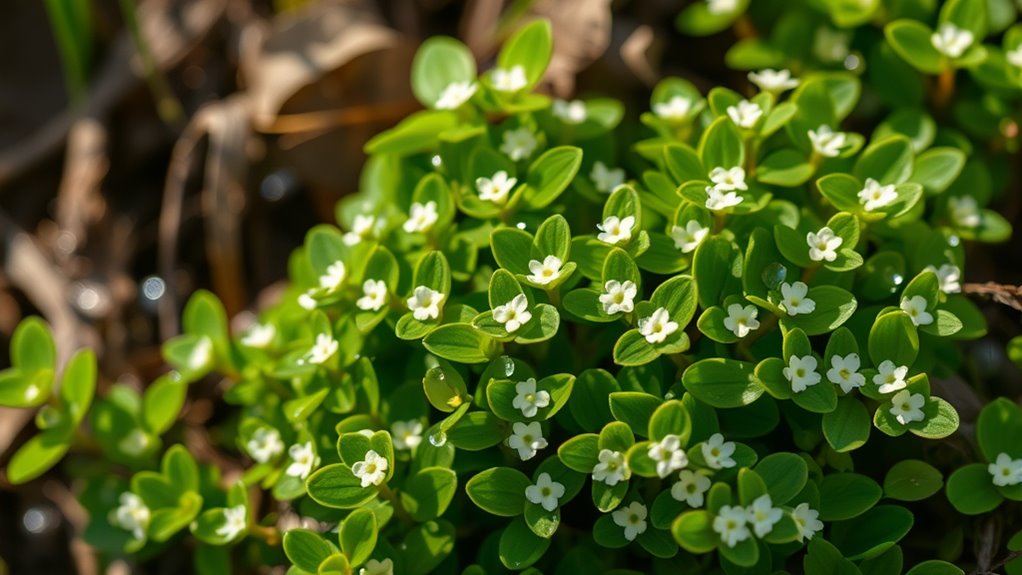
Chickweed (Stellaria media) is a versatile and nutritious spring green that often grows abundantly in North American gardens, lawns, and disturbed areas. When foraging, look for its small, bright green leaves and delicate white flowers, usually found in clusters. Always guarantee the plant is free from pesticides before harvesting. Chickweed has a mild, slightly grassy flavor, making it perfect for salads, sandwiches, or as a garnish. You can also incorporate it into smoothies or use it as a cooked green in soups and stews. Its high vitamin C content adds a healthy boost. When collecting for culinary recipes, pick young, tender leaves for the best taste and texture. Always harvest sustainably, taking only what you need and leaving plenty behind for the plant to thrive. Understanding proper foraging guidelines helps ensure sustainable harvesting and the health of wild populations.
Wild Spinach (Claytonia Virginica)
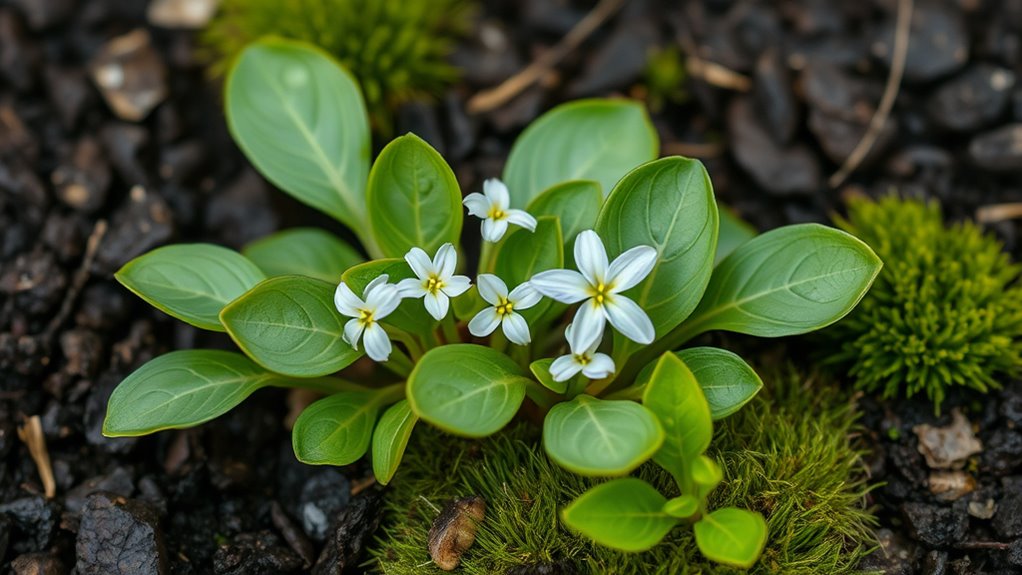
Wild Spinach, or Claytonia Virginica, is easy to identify by its delicate, spoon-shaped leaves and slender stems. When harvesting, pick young, tender leaves before the plant flowers for the best flavor. You can use Wild Spinach in salads, sautés, or as a fresh green in various dishes.
Identification and Harvesting
To identify and harvest wild spinach (Claytonia virginica), focus on its distinctive appearance and growing habits. This plant features small, oval-shaped leaves that are smooth and slightly succulent, often growing in clusters close to the ground. During early spring, it produces tiny white or pinkish flowers with five petals, making it easy to spot. When harvesting, prioritize foraging safety by accurately identifying the plant to avoid confusion with toxic look-alikes. Use sustainable harvesting methods by snipping only a few leaves from each plant, allowing it to continue growing. Always harvest from clean, pesticide-free areas, and never overharvest to ensure the population remains healthy. Proper identification and mindful harvesting support both your safety and the plant’s longevity. Additionally, understanding the plant’s edible qualities helps ensure you enjoy a safe foraging experience.
Culinary Uses
Wondering how to incorporate spring’s fresh greens into your meals? Wild spinach, or Claytonia virginica, adds a vibrant, tender flavor to salads and sautés. You can also experiment with fermentation techniques to create tangy greens or incorporate them into preservation methods like freezing or pickling for year-round enjoyment. Blanching the leaves before freezing preserves their nutrients and texture, while pickling adds a savory twist. Toss chopped wild spinach into smoothies for a nutrient boost or sauté with garlic and olive oil for a quick side dish. These greens can also be dried for later use in soups or stews. By exploring different culinary uses, you maximize their flavor and nutritional value, making wild spinach a versatile addition to your springtime meals. Incorporating automation technology into the process can help streamline your preparation and storage methods.
Miner’s Lettuce (Claytonia Perfoliata)
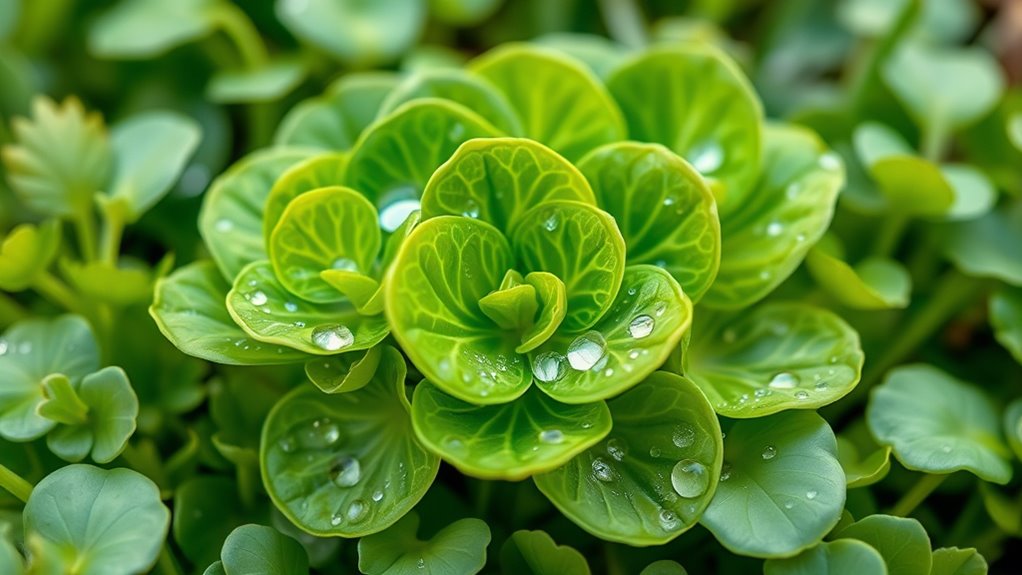
Miner’s lettuce (Claytonia perfoliata) is a popular spring green known for its tender leaves and mild, spinach-like flavor. During spring green foraging, you’ll find it thriving in shady, moist areas. Its edible plant identification is straightforward: round, perfoliate leaves that appear to wrap around the stem, with small white flowers in early spring. You can enjoy it raw in salads or as a garnish. Be cautious to differentiate it from similar plants that may be toxic. Here’s a quick comparison:
| Edible Plant | Key Features | Habitat |
|---|---|---|
| Miner’s Lettuce | Perfoliate leaves, white flowers | Shady, damp areas |
| Wild Sorrel | Sour taste, arrow-shaped leaves | Open fields, edges |
| Wood Sorrel | Heart-shaped leaves, tangy flavor | Woodlands |
This plant is essential for safe edible plant identification and springtime foraging adventures. Correct identification is crucial to ensure safe consumption when foraging for miner’s lettuce.
Sorrel (Rumex Spp.)
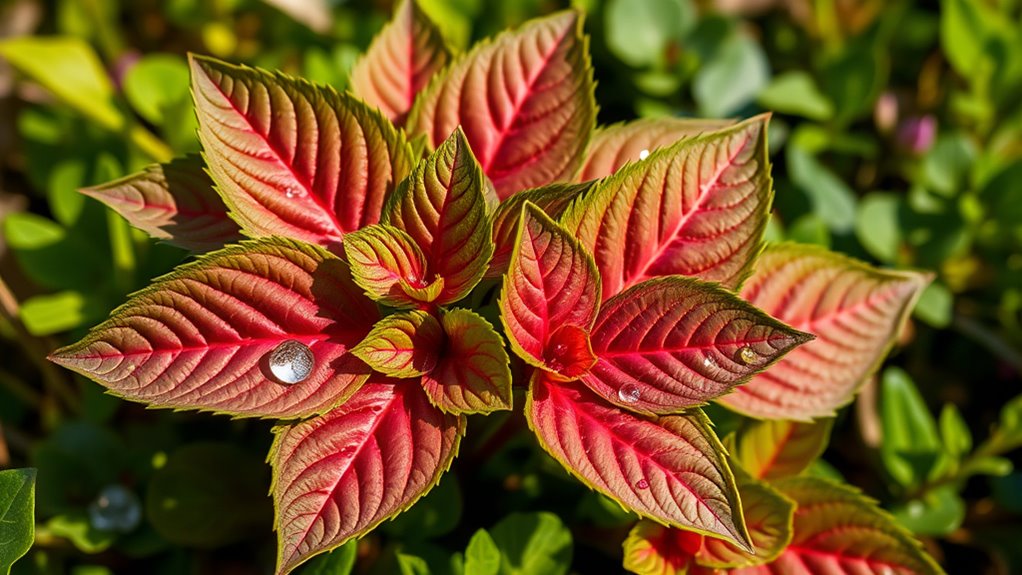
Have you ever tasted the tangy, lemony flavor of sorrel? If so, you’ll appreciate its bright, acidic zest in salads or soups. Foraging tips include identifying its arrow-shaped leaves and avoiding plants with red stems that aren’t sorrel. Cultivation methods are straightforward: plant seeds in well-drained soil with partial sunlight, and keep the soil moist. Sorrel thrives in temperate climates and can be harvested multiple times during spring. Here are some key points:
Discover sorrel’s tangy flavor—perfect for salads and soups, with easy growing tips.
- Identify sorrel by its distinct leaves and stems.
- Forage responsibly, ensuring proper plant ID.
- Grow sorrel in nutrient-rich soil with partial sun.
- Harvest regularly to encourage new growth.
Mustard Greens (Brassica Spp.)
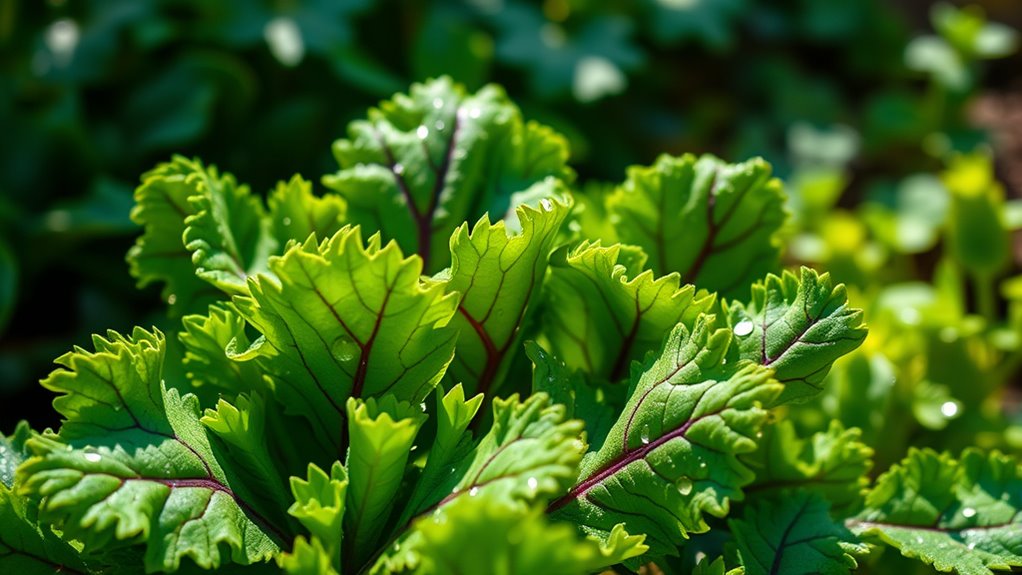
Mustard greens pack a nutritional punch, offering vitamins A, C, and K along with antioxidants. Their bold, peppery flavor adds a lively kick to many dishes, from salads to sautés. You’ll find that their versatility makes them a staple in both traditional and modern recipes.
Nutritional Benefits of Mustard Greens
Mustard greens are a powerhouse of essential nutrients that can boost your health in numerous ways. They’re rich in vitamins A, C, and K, supporting your immune system, vision, and blood clotting. Their high antioxidant content helps combat oxidative stress, promoting overall wellness. Additionally, mustard greens contain calcium and iron, which strengthen bones and improve blood health. Their nutrient density also supports plant growth and soil health, making them an eco-friendly choice. Incorporating mustard greens into your diet can enhance energy levels and strengthen your immune response.
- Boosts immune function with vitamins and antioxidants
- Supports bone health through calcium and vitamin K
- Promotes healthy blood flow via iron content
- Enhances plant growth and soil health naturally
Flavor Profile and Culinary Uses
Known for their bold and peppery flavor, mustard greens add a distinctive kick to a variety of dishes. Their spicy, mustard-like taste pairs well with ingredients like garlic, bacon, and tangy vinaigrettes. You can sauté them with olive oil and garlic for a simple side or add them to soups and stews for extra flavor. For salads, toss raw leaves with lemon juice and a touch of salt to balance the spice. To preserve their flavor, consider preservation techniques like blanching and freezing or pickling for longer storage. When pairing, avoid overly delicate ingredients that might get overwhelmed by their strong taste. Whether fresh or cooked, mustard greens lend a lively, pungent note that enlivens many culinary creations.
Wood Sorrel (Oxalis Spp.)
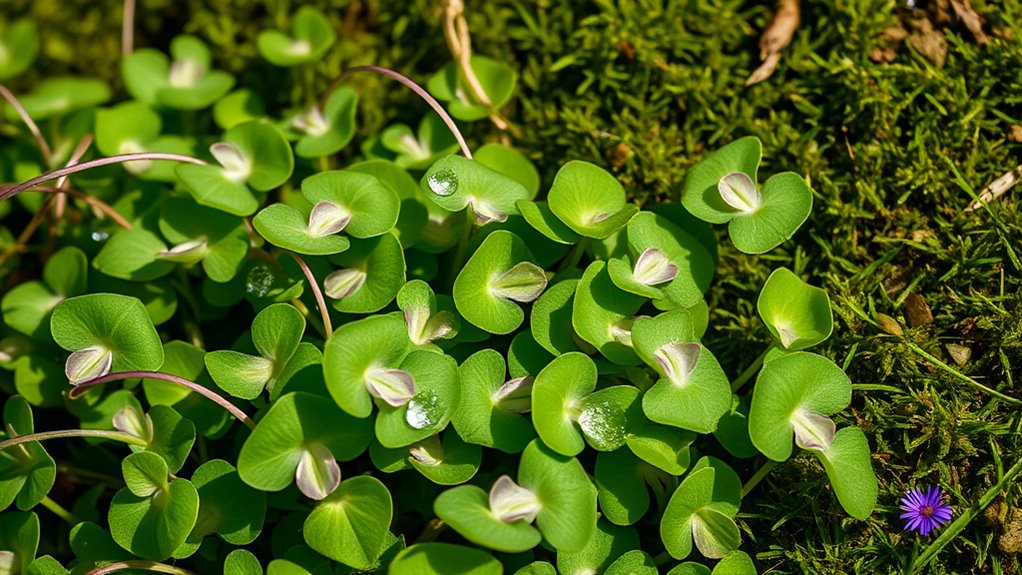
Wood sorrel (Oxalis spp.) is a delightful edible green that grows abundantly in many North American woodlands and lawns. You can harvest its tender leaves and tiny flowers as fresh, tangy additions to salads, making it a perfect spring foraging tip. Its bright, lemony flavor adds a invigorating zest to your greens. When foraging, look for heart-shaped leaves and vibrant blossoms, ensuring you’re harvesting from safe, pesticide-free areas. Keep these tips in mind:
- Identify wood sorrel by its distinctive trifoliate leaves and sour taste.
- Pick young, tender leaves for the best flavor.
- Incorporate into salads, smoothies, or as a garnish.
- Harvest sustainably, don’t overpick from the same spot.
Enjoy this wild green while it’s in season, adding variety and nutrition to your spring foraging adventures.
Cattails (Typha Spp.)
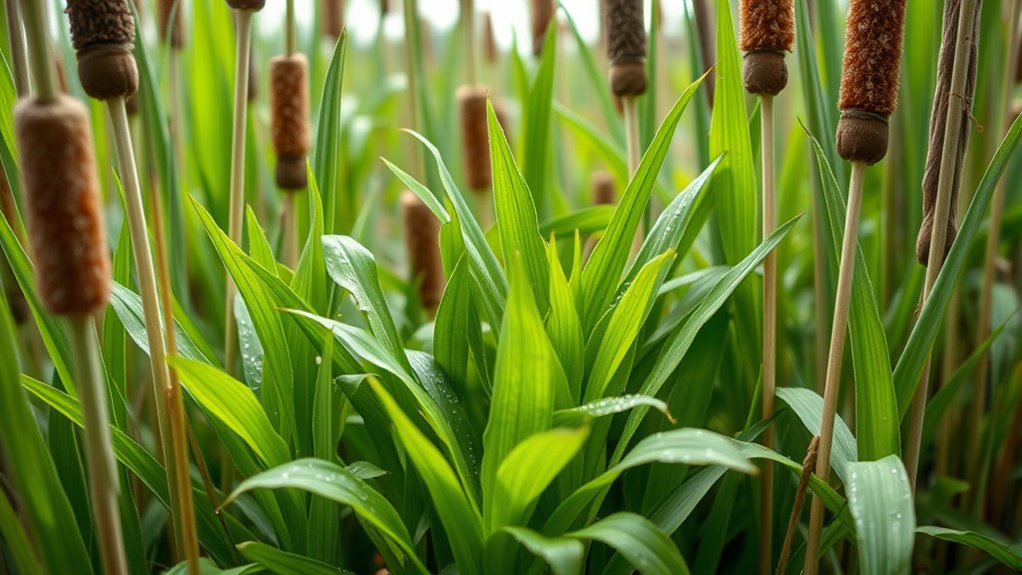
Cattails (Typha Spp.) are versatile marsh plants that offer a nutritious and edible resource during springtime in North America. You can harvest the young shoots and tender rhizomes, which are rich in starches and nutrients. To do so, use simple foraging techniques: look for cattails in shallow marshes, ponds, or wetlands with muddy bottoms. They prefer habitats with abundant water and minimal disturbance. When harvesting, identify the green, firm shoots in early spring, and avoid plants near pollution sources. Here’s a quick guide:
| Foraging Techniques | Habitat Preferences |
|---|---|
| Harvest young shoots | Shallow marshes and ponds |
| Extract rhizomes | Wetlands with muddy bottoms |
| Avoid mature parts | Areas free from pollution |
| Use sharp tools carefully | Calm, freshwater environments |
Frequently Asked Questions
Are Any of These Greens Safe for Pregnant Women to Eat?
When considering greens during pregnancy, your main concern is pregnant women safety. Many fresh, edible spring greens are safe if properly washed and prepared, but some may carry risks like bacteria or high vitamin A levels. Always consult your healthcare provider before adding new greens to your diet. Eating a variety of well-washed, fresh greens can be healthy, but moderation is key to guarantee safety during pregnancy.
How Do I Identify These Greens in the Wild?
First, find familiar features like leaf shape, color, and texture to tackle foraging tips and identification challenges. Focus on features such as leaf margins, stem color, and growth habits. Look for distinct characteristics, and compare your find with trusted guides or images. Practice patience, and always double-check before harvesting. Remember, careful identification keeps your foraging safe and satisfying, so trust your senses and proceed cautiously.
Can These Greens Be Eaten Raw or Should They Be Cooked?
You can often enjoy these greens raw, especially in salads, but it’s wise to wash them thoroughly first. Some greens have tougher textures or bitter flavors, so cooking methods like steaming, sautéing, or boiling can improve taste and digestibility. Always consider the specific green’s safety and flavor profile before deciding between raw consumption and cooking. When in doubt, lightly cooking is a safe way to enjoy their nutrients without losing too much flavor.
Are There Any Health Risks Associated With Consuming These Greens?
Have you ever wondered what hidden dangers might lurk in your greens? While most edible spring greens are safe, you should be aware of potential toxicity concerns and allergy risks. Some greens may contain natural toxins or cause allergic reactions in sensitive individuals. Always wash thoroughly, source from reputable providers, and consult a healthcare professional if you have allergies. Are you prepared to enjoy these greens safely?
What Are the Best Seasons to Harvest Each of These Greens?
You should focus on seasonal harvesting to enjoy greens at their peak freshness and flavor. Typically, these greens are best harvested in spring when they’re most tender, but regional availability varies. For instance, wild greens like nettles and ramps thrive early spring in many areas. Always check local harvest seasons to guarantee you’re picking at the right time, maximizing both flavor and nutritional value while respecting regional growing cycles.
Conclusion
Now that you know these top 10 edible spring greens, aren’t you excited to forage and incorporate them into your meals? Exploring nature’s bounty not only boosts your diet but also connects you to the seasons. With a little knowledge, you can enjoy fresh, wild greens right outside your door. So, why not start your spring foraging adventure today and discover what delicious, nutritious greens await you in North America’s wild landscapes?

